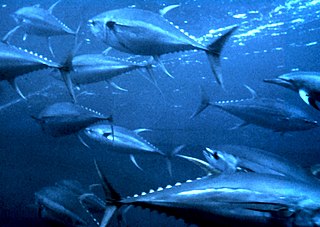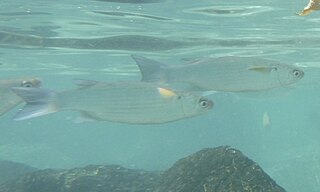
Mackerel is a common name applied to a number of different species of pelagic fish, mostly from the family Scombridae. They are found in both temperate and tropical seas, mostly living along the coast or offshore in the oceanic environment.

Herring are various species of forage fish, belonging to the order Clupeiformes.

Sardine and pilchard are common names for various species of small, oily forage fish in the herring suborder Clupeoidei. The term 'sardine' was first used in English during the early 15th century; a somewhat dubious etymology says it comes from the Italian island of Sardinia, around which sardines were once supposedly abundant.

Sprat is the common name applied to a group of forage fish belonging to the genus Sprattus in the family Clupeidae. The term also is applied to a number of other small sprat-like forage fish. Like most forage fishes, sprats are highly active, small, oily fish. They travel in large schools with other fish and swim continuously throughout the day.

Thunnus is a genus of ocean-dwelling, ray-finned bony fish from the mackerel family, Scombridae. More specifically, Thunnus is one of five genera which make up the tribe Thunnini – a tribe that is collectively known as the tunas. Also called the true tunas or real tunas, Thunnus consists of eight species of tuna, divided into two subgenera.
The Jackson's barb is a species of cyprinid fish.
Synodontis matthesi is a species of upside-down catfish endemic to Tanzania where it occurs in the Rufiji River basin. This species grows to a length of 30 centimetres (12 in) TL.

Eels are ray-finned fish belonging to the order Anguilliformes, which consists of eight suborders, 20 families, 164 genera, and about 1000 species. Eels undergo considerable development from the early larval stage to the eventual adult stage and are usually predators.

An anchovy is a small, common forage fish of the family Engraulidae. Most species are found in marine waters, but several will enter brackish water, and some in South America are restricted to fresh water.
The Congo barb is a species of ray-finned fish belonging to the family Cyprinidae, the family which includes the carps, barbs and related fishes. This species is found in the basin of the Congo River in the Democratic Republic of Congo; and in the Ruzizi River in Burundi and the Malagarasi River in western Tanzania in East Africa.
Clypeobarbus is a genus of small cyprinid fishes native to Africa. Most species are restricted to the Congo River Basin, but C. pleuropholis is also found in the Chad Basin, while C. bellcrossi is from the Zambezi and C. hypsolepis is from rivers in Western Africa.
Clypeobarbus bomokandi is a species of ray-finned fish in the genus Clypeobarbus from the Congo Basin.
Clypeobarbus bellcrossi, the gorgeous barb, is a species of cyprinid fish native to Africa where it is found in the headwaters of the upper Zambezi River system. This species can reach a length of 9 centimetres (3.5 in) TL. It can also be found in the aquarium trade.
Clypeobarbus hypsolepis a species of ray-finned fish belonging to the family Cyprinidae, the family which includes the carps, barbs and related fishes. This species is found in West Africa where it is known from the Niger River and the upper basins of the Volta, Bandama and Agnéby River in Burkina Faso, Mali, Guinea, Ghana, Ivory Coast and Nigeria, with a disjunct population in the Niger Delta.
Clypeobarbus pseudognathodon is a species of ray-finned fish in the genus Clypeobarbus from central Africa where it is known from Lake Mweru, the Lobo River and the upper Lualaba River. Its max size is 5.5 centimeters.
Clypeobarbus schoutedeni is a species of cyprinid fish endemic to the Democratic Republic of the Congo where it is only known from the Dungu River. This species can reach a length of 3.8 centimetres (1.5 in) TL.

The corsula is a species of ray-finned fish from the mullet family Mugilidae. It is found in the rivers and estuaries of southern Asia, in India, Bangladesh, Nepal and Myanmar. It is presently regarded as the only species in the monospecific genus Rhinomugil.

Crenimugil heterocheilos, the half fringelip mullet, is a species of ray-finned fish in the family Mugilidae. It is found throughout the Indo-Pacific Ocean.









